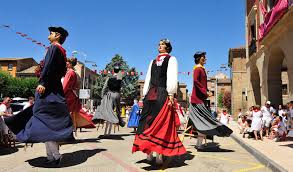Tradition of esquelas tudela

Step into the enchanting world of esquelas Tudela, a tradition steeped in history and rich cultural significance. Explore the intricate process of crafting these unique tributes, discover the timeless themes and symbols that grace their pages, and witness firsthand how modern adaptations are reshaping this age-old practice. Join us on a journey through time as we uncover the deep-rooted legacy of esquelas Tudela.
Historical and cultural significance of esquelas tudela
The tradition of esquelas tudela holds deep historical and cultural significance in the Basque region. Originating from Tudela, a small town in Navarre, Spain, these funeral notices have been a vital part of local customs for generations.
Esquelas tudela serve as a way to honor and remember the deceased while also providing comfort to their loved ones. The intricate designs and heartfelt messages found in these announcements reflect the close-knit community’s respect for those who have passed on.
Through esquelas tudela, stories of individuals’ lives are shared, creating a collective memory that strengthens familial bonds and upholds traditions. It is not just about announcing a death; it is about celebrating a life lived and acknowledging the impact they had on those around them.
As time passes and technology advances, the practice of creating esquelas tudela has evolved. While some may opt for digital formats or online platforms to share these notices now, the essence of honoring one’s legacy remains unchanged.
The process of creating an esquela tudela
Crafting an esquela tudela is a meticulous process that honors the memory of the deceased in a truly special way. The first step involves gathering essential information about the person, such as their name, date of birth, and details about their life.
Next comes selecting the design elements and layout for the esquela, which often includes religious symbols or images that hold significance to the individual being remembered. The text is carefully composed to capture the essence of their life story and convey messages of love and remembrance.
Once all details are finalized, skilled artisans meticulously handcraft each esquela with precision and care. The final product is a beautiful tribute that serves as both a memorial and a celebration of life.
Creating an esquela tudela requires skill, attention to detail, and most importantly, heart. It’s a meaningful process that pays homage to those who have passed on while providing comfort and solace to those left behind.
Common themes and symbols found in esquelas tudela
When it comes to esquelas tudela, common themes and symbols play a significant role in conveying messages of love, respect, and remembrance. One prevalent theme is the use of religious symbols such as crosses or angels, reflecting the spiritual beliefs of the departed and their families. These symbols serve as a reminder of faith and hope during times of grief.
Floral motifs are another frequent element found in esquelas tudela, representing beauty, renewal, and the fleeting nature of life. Flowers like lilies or roses symbolize purity, love, and eternal rest. Additionally, depictions of landscapes or peaceful scenes evoke feelings of tranquility and serenity for both the deceased and those left behind.
In some cases, personalized elements such as hobbies or interests are incorporated into esquelas tudela to celebrate the unique essence of the individual being honored. Whether it’s a musical note for a music lover or a soccer ball for a sports enthusiast – these details add depth to the tribute paid through these traditional announcements.
Overall (I’m sorry I didn’t get that), each theme and symbol used in esquelas tudela holds its own significance in commemorating lives lived and cherished memories shared.
Modern adaptations and changes to the tradition
In the modern era, the tradition of esquelas tudela has evolved to embrace new technologies and changing cultural norms. With the rise of digital platforms and social media, families now have the option to share their tributes online, reaching a wider audience beyond print newspapers.
Furthermore, contemporary esquelas tudela may feature more personalized touches such as photos, artwork, or unique messages that reflect the individuality of the deceased. These adaptations allow for a richer and more expressive tribute to be shared with loved ones and communities.
Additionally, some families opt for eco-friendly alternatives in creating esquelas tudela by using recycled paper or choosing digital formats over traditional printed versions. This shift towards sustainability aligns with current environmental concerns and demonstrates a commitment to reducing waste.
These modern adaptations ensure that the tradition of esquelas tudela remains relevant and meaningful in today’s fast-paced world while honoring its historical roots.
Impact of technology on the practice of esquelas tudela
In a rapidly evolving digital age, the practice of esquelas tudela has not been immune to the impact of technology. Traditionally handwritten and posted in newspapers, today’s esquelas often find their way online through dedicated websites and social media platforms.
Technology has made it easier for families and friends to share memories and condolences with a wider audience beyond local communities. The convenience of digital platforms allows for immediate updates and notifications, ensuring that no one is left out when honoring the memory of a loved one.
However, some may argue that this shift towards digitalization can diminish the personal touch and intimacy that comes with physical esquelas. While technology offers efficiency and reach, there is something irreplaceable about seeing a heartfelt tribute in print or receiving a tangible keepsake in hand.
Despite these advancements, the essence of honoring those who have passed remains at the core of esquelas tudela – whether through paper or pixels, tradition endures amidst technological progress.
Personal experiences and anecdotes related to the tradition
Growing up in a small town surrounded by the beauty of nature, I have vivid memories of the tradition of esquelas tudela woven into the fabric of our community. The sight of families coming together to create heartfelt tributes for their loved ones always left a lasting impression on me.
One particular experience that stands out is when my family gathered around the kitchen table, poring over old photographs and sharing cherished stories to capture the essence of our dearly departed. It was a bittersweet moment filled with laughter and tears, as we carefully crafted our esquela tudela to honor their memory.
I remember feeling a sense of connection and reverence as we placed the finished esquela in the local newspaper, knowing that it would be a tribute visible to all who knew and loved them. These personal experiences have shaped my understanding and appreciation for this beautiful tradition passed down through generations.
Conclusion: The enduring legacy of esquelas tudela
The tradition of esquelas Tudela has stood the test of time, weaving together history, culture, and personal connections in a unique and meaningful way. From its humble origins to modern adaptations, this practice continues to hold a special place in the hearts of many. The artistry and symbolism found in esquelas Tudela reflect not only individual lives but also the larger community they are part of.
As technology advances and society evolves, the tradition of esquelas Tudela may undergo changes to adapt to new ways of honoring loved ones. However, its enduring legacy lies in its ability to capture memories, emotions, and cultural traditions for generations to come. Esquelas Tudela serves as a timeless tribute that celebrates life and commemorates those who have passed on, connecting past with present in a beautiful tapestry of remembrance.





